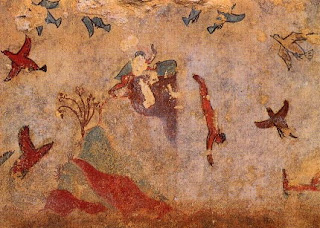Wednesday, November 10th, 2010
The Minoans as Hippies (and an Etruscan Thought)
When I was an undergrad, one of my professors liked to compare the Minoans to the hippies of the 1960s. My teacher isn’t the only one who has made this comparison. In fact, recently Minoan lilies were cleverly dubbed “the ancient equivalent of flower power.”1
My teacher pointed out that the Minoans were very interested in nature (as evident in their art, which often depicts animals and plants) and used opium. And I think one could even (jokingly) say that the bright colors in some of the frescoes (like the hills in the Spring Fresco from Akrotiri, Thera, before 1630 BCE, shown above left) are “psychedelic.”2
I don’t mind the hippie comparison, especially if it can help students to differentiate between the Minoan and Mycenaean civilizations. I do think it’s important, though, for students to know that the comparison isn’t perfect. For example, the fact that the Minoans had fortifications (despite what Sir Arthur Evans argued) and were possibly involved in human sacrifices suggest that these people weren’t all about love and peace.
 Speaking of Minoans and the Spring Fresco, I was struck today about how there are some similarities between this painting and a tomb painting from the Etruscan period (“Boys Climbing Ricks and Diving,” from Tomb of Hunting and Fishing in Tarquinia, late 6th century BC, shown right). Both paintings depict brightly colored hills (with the mounds divided into multiple colors). In both cases, the hills are adorned with spindly vegetation (the Spring Fresco depicts stylized lilies, but I don’t think there is enough detail to identify the Etruscan plant). Additionally, the two paintings have birds darting about in the air. I know that over 1,000 years separate these frescoes (not to mention that they are from different geographic areas – the Minoans were on islands in the Aegean Sea and the Etruscans were on mainland Italy), but I think the similarities are interesting.
Speaking of Minoans and the Spring Fresco, I was struck today about how there are some similarities between this painting and a tomb painting from the Etruscan period (“Boys Climbing Ricks and Diving,” from Tomb of Hunting and Fishing in Tarquinia, late 6th century BC, shown right). Both paintings depict brightly colored hills (with the mounds divided into multiple colors). In both cases, the hills are adorned with spindly vegetation (the Spring Fresco depicts stylized lilies, but I don’t think there is enough detail to identify the Etruscan plant). Additionally, the two paintings have birds darting about in the air. I know that over 1,000 years separate these frescoes (not to mention that they are from different geographic areas – the Minoans were on islands in the Aegean Sea and the Etruscans were on mainland Italy), but I think the similarities are interesting.
1 Mary Beard, “Knossos: Fakes, Facts, and Mystery,” in The New York Review of Books (August 13, 2009). Available online here.
2 However, I only make the psychedelic comparison with students as a joke. It has been noted that the bright colors of the rocks are actually quite naturalistic. “The colors may seem fanciful to us, but sailors today who know the area well attest to their accuracy, suggesting that these artists recorded the actual color of Thera’s wet rocks in the sunshine, a zestful celebration of the natural world.” See Stokstad, Art History, 4th ed. (Upper Saddle River, New Jersey: Prentice Hall, 2011), 92.



